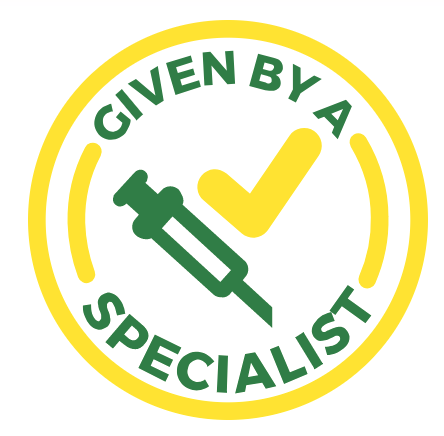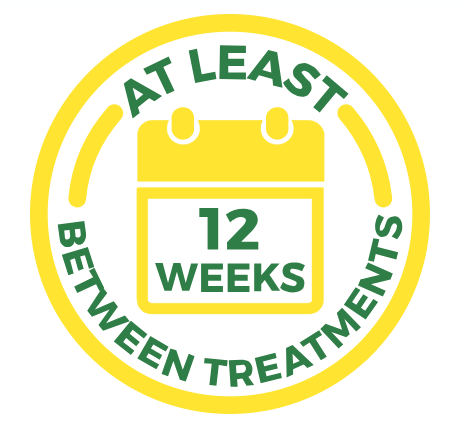Patient experience
In a global Internet-based survey – Patients Living With Spasticity – almost 1 in 4 patients living with spasticity reported a duration of response of their treatment of less than 3 months.
How is Dysport treatment given?
Dysport is given by a specialist, and treatment is based on your individual needs
Here’s what may happen during a typical office visit:
- Dysport is given as an injection into your affected muscles
- Depending on how many muscles are affected, your doctor may give you injections in a few different muscles or change the location of injections
- Your doctor may tailor the amount of injections or dose of Dysport to your individual needs

Results After Injection
For adults with upper limb spasticity, approximately 3 out of 4 patients had a response to treatment at week 4, as measured by a reduction in stiffness in the elbow, wrist, or finger muscles. For adults with lower limb spasticity, nearly half of patients treated with Dysport had a response to treatment at week 4, as measured by a reduction in muscle stiffness at the ankle joint.
Common side effects
The most common side effects of Dysport in adults with upper limb spasticity include:
- muscle weakness
The most common side effects of Dysport in adults with lower limb spasticity include:
- muscle weakness
- pain in your arms or legs
- fall
Tell your doctor if you have any side effect that bothers you or that does not go away. These are not all the possible side effects of Dysport. For more information, ask your doctor or pharmacist. You may report side effects to the FDA at www.fda.gov/medwatch or call 1-800-FDA-1088.
In a clinical trial, most patients needed treatment again between 12 and 16 weeks. Some had a longer response and were treated again at 20 to 24 weeks.
After you have an injection of Dysport, the effects of treatment will lessen over the next several weeks. Because Dysport injection therapy is not a cure, another treatment session will be needed to reduce muscle stiffness. Treatment with Dysport can be repeated when the benefits from the previous treatment have decreased, but there should be at least 12 weeks between treatments. Your doctor will decide when you are ready for another Dysport treatment session.

The most important safety information you should know about Dysport
Dysport may cause serious side effects, including problems breathing or swallowing and/or spread of toxin effects, that can be life threatening and death can happen as a complication. These problems can happen within hours, or days to weeks after an injection of Dysport.
Tracking Progress with Dysport
Tracking your experience after a Dysport injection can be a helpful tool in your discussions with your doctor about treatment for adult spasticity. Take notes on how your symptoms have changed and how you are feeling. Discuss your notes with your doctor at your next appointment about how Dysport may have helped those symptoms. Some things to track include:
- What is your expectation while on treatment?
- What changes have you noticed in your muscle stiffness since your first injection?
- Have you noticed anything different about how you are able to move your arms and legs?
- What improvements have you seen since your last Dysport injection?
- Have you experienced any side effects?
- Are you experiencing any new symptoms?
- What is your typical day like?
Learn more about Adults with Spasticity
IMPORTANT SAFETY INFORMATION
What is the most important safety information I should know about Dysport?
Dysport may cause serious side effects, including problems breathing or swallowing and/or spread of toxin effects, that can be life threatening and death can happen as a complication. These problems can happen within hours, or days to weeks after an injection of Dysport.
- Problems swallowing, breathing, or speaking. Treatment with Dysport can result in swallowing or breathing problems. People with pre-existing swallowing or breathing problems may be at greater risk following treatment with Dysport. Swallowing problems may last for several weeks; you may need a feeding tube to receive food or water. If swallowing problems are severe, food or liquids may go into your lungs.
- Spread of toxin effects. The effects of botulinum toxin may affect areas of the body away from the injection site and cause symptoms of a serious condition called botulism which include: loss of strength and muscle weakness all over the body, double or blurred vision, and drooping eyelids, hoarseness or change or loss of voice, trouble saying words clearly, loss of bladder control, and trouble breathing or swallowing. The risk of these symptoms is probably greatest in children treated for spasticity. These problems could make it unsafe for you to drive a car, operate machinery, or do other dangerous activities.
Call your doctor or get medical help right away if you experience these problems after treatment with Dysport.
Do not receive a Dysport injection if: you are allergic to Dysport or any of its ingredients, or cow’s milk protein; you had an allergic reaction to any other botulinum toxin product, such as Myobloc®, Botox®, or Xeomin®; or you have a skin infection at the planned injection site.
Before you receive a Dysport injection tell your doctor:
- About all your medical conditions, including if you have a disease that affects your muscles and nerves (such as ALS or Lou Gehrig’s disease [amyotrophic lateral sclerosis], myasthenia gravis, or Lambert-Eaton syndrome). You may be at increased risk of serious side effects, including difficulty swallowing or breathing.
- If you have or have had any of the following: a side effect from any botulinum toxin in the past; problems with breathing such as asthma or emphysema; swallowing; bleeding; diabetes; and slow heartbeat, or problems with your heart rate or rhythm.
- If you have plans to have surgery, had surgery on your face, have weakness of your forehead muscles (trouble raising your eyebrows), drooping eyelids, or any other change in the way your face normally looks.
- If you are pregnant or breastfeeding or plan to become pregnant or breastfeed. It is not known if Dysport can harm your unborn baby or if it passes into breast milk.
- About all the medicines you take, including prescription and over-the-counter medicines, vitamins, and herbal products. Using Dysport with certain other medicines may cause serious side effects. Do not start any new medicines until you have told your doctor that you have received Dysport in the past.
Especially tell your doctor if you have received any other injections of botulinum toxin in the last four months or ever; Myobloc®, Botox®, or Xeomin® (exactly which ones); an antibiotic recently by injection; or if you take muscle relaxants; allergy, cold or sleep medicine.
Most Common Side effects of Dysport in:
- adults with lower limb spasticity include: fall, muscle weakness, pain in your arms or legs.
- adults with upper limb spasticity include: muscle weakness.
- children (2 to 17 years of age) with upper limb spasticity include: upper respiratory infection and sore throat.
- children (2 to 17 years of age) with lower limb spasticity include: upper respiratory infection, stuffy or runny nose and sore throat, cough, and fever.
- adults with cervical dystonia include: muscle weakness, difficulty swallowing, dry mouth, injection site discomfort, tiredness, headache, muscle pain, problems speaking, injection site pain and eye problems.
Tell your doctor if you have any side effect that bothers you or that does not go away. These are not all the possible side effects of Dysport. For more information, ask your doctor or pharmacist. You may report side effects to the FDA at www.fda.gov/medwatch or call 1-800-FDA-1088.
What is Dysport?
Dysport is a prescription medicine that is injected into muscles and used to treat:
- increased muscle stiffness in patients 2 years of age and older with upper and lower limb spasticity
- cervical dystonia (CD) in adults
Please see full Prescribing Information including Medication Guide with Important Warning.
Botox, Xeomin, and Myobloc are registered trademarks of their respective owners.

